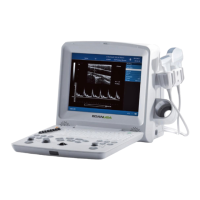DUS 60 Digital Ultrasonic Diagnostic Imaging System Service Manual
- 7 -
2.1.5. Battery Safety
WARNING
1. Improper operation may cause the internal li-ion battery (hereinafter called battery) to
be hot, ignited or exploded, and it may lead to the decrease of the battery capacity. It
is necessary to read the user manual carefully and pay more attention to warning
messages.
2. Only qualified service engineers authorized by the manufacturer can open the battery
compartment and replace the battery, and batteries of the same model and
specification should be used.
3. DANGER OF EXPLOSION -- Do not reverse the anode and the cathode when
installing the battery.
4. Do not heat or splash the battery or throw it into fire or water.
5. Do not destroy the battery; do not pierce battery with a sharp object such as a needle;
do not hit with a hammer, step on or throw or drop to cause strong shock; do not
disassemble or modify the battery.
6. When leakage or foul smell is found, stop using the battery immediately. If your skin or
cloth comes into contact with the leakage liquid, cleanse it with clean water at once. If
the leakage liquid splashes into your eyes, do not wipe them. Irrigate them with clean
water first and go to see a doctor immediately.
7. Properly dispose of or recycle the depleted battery according to local regulations.
8. Only when the device is off can the battery be installed or removed.
9. Remove the battery from the electrocardiograph when the electrocardiograph is not
used for a long time.
10. If the battery is stored alone and not used for a long time, we recommend that the
battery should be charged at least once every 6 months to prevent overdischarge.
2.2. Electromagnetic Compatibility (EMC)
Electromagnetic compatibility describes a level of performance of a device within its
electromagnetic environment. This environment consists of the device itself and its surroundings
including other equipment, power sources and persons with which the device must interface.
Inadequate compatibility occurs when a susceptible device fails to perform as expected due to the
interference from its environment or when the device produces unacceptable levels of emission to
its environment. This interference is often referred to as radio-frequency or electromagnetic
interference (RFI/EMI) and can be radiated through space or conducted over interconnecting
power of signal cables. In addition to electromagnetic energy, EMC also includes possible effects
from electrical fields, magnetic fields, electrostatic discharge and disturbances in the electrical
power supply.

